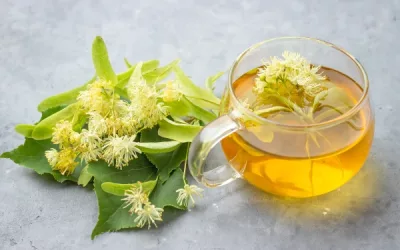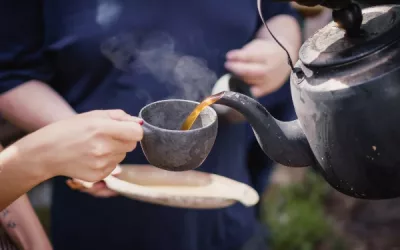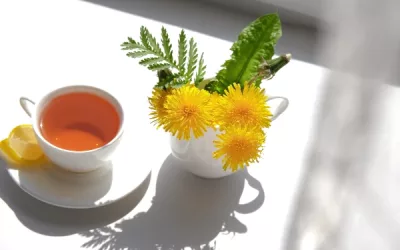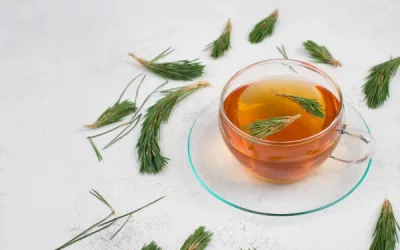Have you ever sipped a cup of tea and wondered if it was doing more for you than just providing warmth? Sage tea, bursting with antioxidants and potential health benefits, isn’t just a comforting brew—it’s a powerhouse of goodness, particularly for those navigating health concerns like diabetes or menopause. In this guide, we’ll explore the remarkable health advantages of sage tea, how to brew the perfect cup, and its role in managing specific conditions. Read on to discover how to harness the healing properties of this delightful herbal infusion.
Table of Content
What is sage tea?
Sage tea is a herbal tea made from the leaves of the sage plant (Salvia officinalis), which is commonly used both for culinary and medicinal purposes. It has a distinctive earthy, slightly peppery flavor with hints of mint. Here are some key points about sage tea:
- Health Benefits:
- Rich in antioxidants, which may help reduce oxidative stress.
- Traditionally used for digestive issues, such as bloating or indigestion.
- Known for its potential to soothe sore throats and reduce inflammation.
- Sage tea has been used in folk medicine to improve cognitive function and memory.
- Some believe it can help with menopausal symptoms, such as hot flashes.
- Preparation:
- Sage tea can be made by steeping 1-2 teaspoons of dried sage leaves (or a handful of fresh leaves) in boiling water for about 5-10 minutes.
- It can be consumed hot or cold, sometimes sweetened with honey or flavored with lemon.
- Cautions:
- Sage contains thujone, a compound that can be toxic in large amounts, so it’s recommended to drink sage tea in moderation.
- Pregnant or breastfeeding women and people with certain medical conditions should consult a doctor before consuming sage tea regularly.
It’s a simple and aromatic tea with various potential health benefits when consumed responsibly.
In medieval Europe, sage was considered a powerful medicinal herb. The 10th-century Arab physician Avicenna even praised its benefits in his famous work “The Canon of Medicine,” highlighting its use for treating memory loss and digestive issues.
This historical context shows how sage has long been valued for its medicinal properties, providing a rich backdrop to its modern-day applications.
I remember when I began drinking sage tea daily after learning about its benefits for cognitive function and skin health. Within a few weeks, I noticed an improvement in my mental clarity and focus, making it easier to tackle work tasks and stay organised.
Additionally, my skin appeared clearer and more radiant, which boosted my confidence. This personal experience has solidified my belief in the power of sage tea as a natural remedy for overall health and well-being.
How can you prepare the perfect cup of sage tea?
When it comes to brewing a delightful cup of sage tea, a few key steps can enhance both its flavour and its health benefits. Sage tea, known for its earthy aroma and potential medicinal properties, requires precise preparation to unlock its full potential.
You want to use fresh or dried sage leaves and ensure you brew them just right.
To make it easy, let’s break down the process into a table that covers everything from brewing methods to steeping times and temperatures. This table will be your go-to guide for the perfect cup every time.
The table provides essential details on how to prepare sage tea using various methods. It includes recommended steeping times and ideal temperatures to bring out the best flavour and benefits. Use the table to choose your preferred brewing method, then follow the specified steeping time and temperature for optimal results.
| Brewing Method | Steeping Time | Temperature |
|---|---|---|
| Traditional Tea Kettle | 5-7 minutes | 85-90°C |
| French Press | 4-6 minutes | 88-92°C |
| Boiling on Stove | 8-10 minutes | 80-85°C |
| Infuser Bottle | 5-7 minutes | 85-90°C |
| Cold Brew | 4-6 hours | Room Temperature |
| Tea Ball Infuser | 5-6 minutes | 85-90°C |
| Microwave Mug | 2-3 minutes | 85-90°C |
What are the best practices for brewing sage tea?
Brewing sage tea isn’t only about following a recipe; it’s about understanding and applying best practices to enhance its flavour and benefits. Here are several tips to ensure your sage tea is top-notch:
- Use fresh or high-quality dried sage leaves to ensure the best flavour and health benefits.
- Always measure the right amount of leaves. Typically, you need one teaspoon of dried leaves or a tablespoon of fresh leaves per cup of water.
- Preheat your teapot or cup before adding the hot water to maintain the right temperature.
- Avoid using boiling water, as it can make the tea bitter. Aim for the recommended temperature range.
- Steep for the right amount of time specified in the table to avoid over-extraction or under-extraction.
Following these practices will enhance your sage tea experience, making it more enjoyable and beneficial.
How can sage tea benefit your health?
Sage tea isn’t just a comforting beverage; it brings various health benefits, especially for those dealing with specific conditions like diabetes, menopause, or cognitive decline. Here are some potential health benefits:
- Anti-Inflammatory Properties: Sage contains compounds that may help reduce inflammation in the body.
- Antioxidant Rich: It’s packed with antioxidants that help combat oxidative stress and support overall health.
- Cognitive Support: Some studies suggest sage can enhance memory and brain function.
- Blood Sugar Regulation: Sage may help regulate blood sugar levels, potentially benefiting those with diabetes.
- Menopausal Relief: Drinking sage tea can alleviate some symptoms of menopause, such as hot flashes.
- Digestive Aid: Sage tea can aid in digestion, helping with issues like bloating and gas.
By understanding these benefits, you can appreciate not only the taste of sage tea but also its value for your well-being.
In Ancient Greece, sage was held in high regard. The philosopher Theophrastus, a student of Aristotle, praised this herb in his writings for its medicinal properties. The Greeks believed sage could enhance memory and wisdom, leading to its use in various rituals and medicines.
Monks in medieval Europe later adopted these practices, growing sage in monastery gardens for its believed healing powers. The historical reverence for sage highlights its long-standing importance in herbal medicine.
I remember the first time I tried brewing sage tea. I was intrigued by its reputed health benefits and wanted to give it a go. Armed with a bunch of fresh sage from a local market, I followed a simple recipe.
The aroma that filled my kitchen was incredible—earthy and calming. After steeping the leaves for about seven minutes, I took my first sip. The flavour was unique, a blend of minty freshness with a hint of pine.
It quickly became a staple in my tea collection, especially during the colder months. Now, I enjoy sharing this soothing drink with friends and family, knowing it’s not just delicious but also good for us.
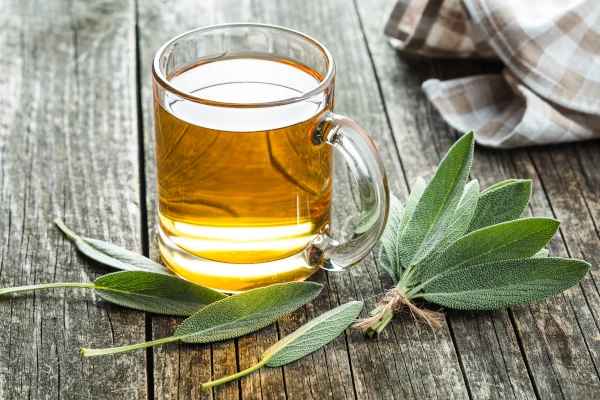
Is sage tea safe for daily consumption?
Alright, let’s chew the cud on whether sage tea is a good idea for your daily cuppa. The good news? Sage tea has been embraced for centuries for its myriad of benefits. But, spoiler alert: Like any good thing, moderation is key.
Drinking sage tea every day can offer several health perks. Think of it as your herbal comrade against ailments like indigestion, menopause symptoms, or even cognitive decline. However, don’t gurgle it by the gallon. Downing buckets of any herbal tea might just turn you into the main character in an “interestingly odd health story” – and not in a good way.
What are the potential side effects of sage tea?
Got your attention? Good. Sage tea is like that friend who’s mostly great but has a few quirks. While sipping it daily might have you feeling extra zen, consider the following tidbits:
- Thujone Trouble: Sage contains a compound called thujone, which can be toxic in high amounts. Just think of it as that club bouncer who will kick you out if you’ve had too much fun.
- Allergic Reactions: It may cause allergic reactions in some people. Rashes, itching and whatnot.
- Gastrointestinal Issues: Too much sage tea can lead to stomach issues. You don’t want to swap a good night’s sleep for a grumbling belly.
- Nervous System Effects: Excessive consumption can lead to restlessness and dizziness. You might feel like you’ve had a bit too much coffee on an empty stomach.
- Blood Pressure Changes: Sage has been known to affect blood pressure so keep an eye out for those head spins.
So, stay savvy, enjoy it but keep tabs on your body’s reactions.
How much sage tea is safe to drink daily?
Now, let’s address the million-pound question: how much of this herbal goodness can you actually pour into your teacup each day without breaking something?
Experts suggest that 3-6 grams of sage leaves per day is a safe bet. To simplify:
- One Cup Rule: Stick to around 1-3 cups of sage tea per day. Don’t get greedy.
- Measure the Leaves: Use roughly a teaspoon of dried sage leaves (about 1 gram) for each cup of tea.
- Dilution Delight: If you’re a fan of brewing large pots, dilute it a bit more than usual.
- Hydration Balance: Pair it with good old water. Don’t let sage tea dominate your hydration game.
Enjoy it in moderation, and you’re golden.
Are there any interactions with medications?
You didn’t think I’d forget about the medication mishmash, did you? The mixology of sage tea with meds requires a bit of homework. Be aware of these potential clashes:
- Anti-seizure Meds: Sage can mess with anticonvulsant drugs. Thujone, remember?
- Diabetes Medications: Sage can lower blood sugar levels, which might double down on the effects of your meds.
- Blood Pressure Drugs: Drinking sage tea can either lower or spike your blood pressure, making it a bit complicated.
- Sedatives: It might enhance the effects, making you feel way too relaxed.
- Hormone-sensitive Conditions: If you’re on oestrogen pills, tread lightly since sage can interact with hormone therapy.
Before you dive into the daily sage ritual, give your GP or dietitian a shout. Let them help steer your herbal ship.
So why is sage tea so popular in the first place? Look no further than good old Emperor Charlemagne. Back in the early days of the Holy Roman Empire, Charlemagne had sage cultivated in his imperial gardens for its perceived medicinal prowess.
It wasn’t just for flavour; he believed it could cure just about everything short of a broken heart. Whether or not he was right, sage tea’s been a herbal staple ever since, one cup at a time.
What are the nutritional values of sage tea?
Listen up, sage tea isn’t just for those Instagrammable aesthetic vibes—there’s actual substance in those leafy green brews. Sage tea packs a punch in the nutritional department. Loaded with fantastic vitamins, minerals, and antioxidants, this herbal tea claims a throne in the wellness world. Before your mind wanders, let’s unpack the wizardry of this aromatic potion.
What vitamins are present in sage tea?
When you’re sipping on sage tea, you’re not just hydrating—you’re diving into a pool of vitamins. Here’s the lowdown on the vitamin profile:
- Vitamin K: Essential for blood clotting and bone health. Think of it as the unsung hero keeping your bones in check.
- Vitamin A: Good for your vision. No, it won’t give you superpowers, but clearer vision is a plus.
- Vitamin C: Known for boosting that immune system. Keep the colds at bay, folks.
- Vitamin E: Antioxidant that battles those pesky free radicals. For when you want better skin without the need for a dozen creams.
- B-vitamins: including B1, B2, and B3 that keep your energy levels soaring and your mood steady.
So, if you’re after a drink that’s practically multivitamins in a mug, sage tea has you sorted.
How does the nutritional value of sage tea compare to other herbal teas?
Alright, being unique has its perks, but how does sage tea stack up against the competition?
- High in Antioxidants: Compared to chamomile and peppermint tea, sage tea stands out with a rich mix of antioxidants.
- More Vitamins: Sage tea has a superior vitamin content, especially in vitamins K, A, and C, compared to many other herbal teas.
- Distinct Flavour: While maybe not a nutrition fact, its unique earthy and slightly peppery flavour sets it apart. It’s like the quirky cousin you can’t help but love.
- Fibre Content: Yes, even tea can have fibre. Higher than average fibre content compared to mints and other herbal concoctions.
- Mineral Wealth: The combination of minerals you won’t easily find in others—magnesium and copper are the game changers here.
This comparison makes it easier to understand why sage tea sits comfortably on the herbal tea totem pole, a bit like a seasoned warrior among tea novices.
What minerals can be found in sage tea?
Minerals—nope, not just found in rocks—your sage tea comes bursting with them.
- Magnesium: Important for over 300 enzymatic reactions. Translation? Crucial for life as we know it.
- Zinc: That friend you need for a robust immune system.
- Copper: For iron absorption and keeping your tissues happy and healthy.
- Calcium: Rock solid (pun intended) for your bones and teeth. Your skeleton will thank you.
- Iron: Keeps your blood well-stocked and oxygen flowing. No one likes feeling faint, right?
That’s a gold mine in a single tea mug, making those minerals the silent backstage crew ensuring everything runs smoothly.
Now, let’s time travel a bit. In ancient Greece, sage wasn’t just dunked in water for a soothing drink. The philosopher Dioscorides, known for his work “De Materia Medica“, praised sage as a miracle herb.
His texts from around 50 AD highlight sage’s healing properties, from stopping bleeding to promoting menstruation. Imagine sage being the rockstar herb in a world without antibiotics! His work laid the groundwork for herbal medicine, and sage tea’s continued popularity today is a salute to those ancient insights.
Kind of cool, eh?
So, next time you’re sipping on your sage tea, take a moment to nod to Dioscorides.
How does sage tea compare to other herbal teas?
Alright, let’s dive straight into the tea – literally. Sage tea isn’t your run-of-the-mill herbal tea. It stands out in a myriad of ways: flavour profile, health perks, cultural weight, and how you prepare it. So, grab your metaphorical teacup and let’s spill the details.
When you’re looking to impress your taste buds and rejuvenate your body, sage tea might just be the herbal concoction you’ve been seeking. Unlike other popular teas like peppermint or chamomile, sage tea has its own distinct character. Understanding the differences and similarities between them can help you appreciate what each one brings to the table of life.
How does the flavour of sage tea differ from other herbal teas?
Let’s be honest, flavour is often what seals the deal.
- Sage tea: Earthy, robust, and slightly peppery. Imagine taking a refreshing walk through a pine forest; that’s sage for you.
- Peppermint tea: Minty and cool. Peppermint is like kissing a candy cane. Great for feeling refreshed or pretending you’re a living, breathing breath mint.
- Chamomile tea: Floral and mildly sweet. It’s akin to lying in a meadow, being lulled to sleep by a gentle breeze.
- Hibiscus tea: Tart and tangy, with a crimson hue. Think cranberry juice but with less sugar and more ‘zing’.
- Ginger tea: Spicy and warming. This one’s like a comforting hug from your grandma who knows you love a good kick.
So, flavour-wise, sage tea tends to be a bit more complex and grounded compared to the lightness of chamomile or the sharpness of peppermint.
What unique health benefits does sage tea offer?
We drink herbal teas for more than just their taste, right? Sage tea brings some unique health benefits to the mix.
- Cognitive Support: Sage is renowned for enhancing memory and mental function. Thank the rosmarinic acid and antioxidants for keeping those brain cells sharp.
- Digestive Aid: Say goodbye to bloating. Sage tea helps in digesting those heavy meals and can alleviate indigestion.
- Anti-inflammatory Properties: Sage is like nature’s ibuprofen, reducing inflammation thanks to compounds like carnosic acid.
- Menopausal Relief: Sage tea reduces hot flashes and night sweats, making menopause a little less sweaty and cranky.
- Blood Sugar Control: If you’re managing diabetes, sage plays a role in regulating glucose levels.
Not every herbal tea can boast cognitive boosts and menopausal relief, making sage tea a standout in a crowded field.
How are preparation methods for sage tea different from other herbal teas?
Let’s get down to the ‘brew’ of things.
- Leaves vs. Roots: Sage tea is usually prepared from dried or fresh leaves, which you steep, unlike ginger tea that often uses slices of the root.
- Steeping Time: Generally, sage tea requires a shorter steeping time (around 5-10 minutes) compared to tougher herbs like licorice root or ginseng that need more simmering to extract the goodness.
- Add-Ins: People often add lemon or honey to sage tea for additional flavour, but it stands strong on its own. Compare this to chamomile which often needs a bit of extra sweetness or peppermint which loves some honey or agave.
- Cultural Preparation: In many Mediterranean cultures, sage is more than just a tea – it’s a ritual. Prepared similarly to how one might prepare a sacred brew, sage holds a special place in cultural health traditions.
The sage tea preparation is a bit of a crossover between the simplicity of steeping peppermint and the cultural reverence of brewing matcha.
Historically, sage has held an emblematic status. Take Ancient Greece, where sage was considered sacred, often used in ceremonies to drive away evil spirits. They believed sage possessed almost mystical healing properties.
Meanwhile, in Ancient Rome, sage was so valued that harvesting it was a ritualistic affair involving specific tools and a white toga. This historical flair adds an additional layer of significance to sipping sage tea today.
So next time you brew yourself a cup of sage tea, remember you’re not just brewing leaves; you’re steeping yourself in centuries of tradition and unique health benefits. Cheers!
Conclusion
As I reflect on the myriad health benefits and uses of sage tea shared throughout this article, it becomes clear just how valuable this humble herbal infusion can be. We’ve explored its antioxidant properties, which play a crucial role in combatting oxidative stress, and its potential to boost cognitive function, creating a mental sharpness that many of us strive for daily.
Not to mention, sage tea’s benefits for skin health and its ability to aid digestion reveal that it is not merely a soothing drink but a multifaceted remedy that can enhance overall well-being.
The importance of sage tea extends beyond its impressive health benefits; its role in managing symptoms of menopause is particularly noteworthy, offering a natural alternative for many.
The discussions surrounding its practical preparation methods, safety for daily consumption, and nutritional values underscore that incorporating sage tea into one’s routine is both manageable and rewarding.
Moreover, the comparisons made between sage tea and other herbal teas highlight its unique flavour profile and distinctive health benefits, setting it apart in the vast world of herbal remedies.
While sage tea is indeed a potent ally in health management, it is important to consume it mindfully and consider individual health conditions, especially when it comes to potential interactions with medications.
I encourage those interested in herbal remedies to experiment with different preparation methods to find what resonates best with their taste buds, and perhaps keep a journal noting how sage tea impacts their health journey.
As we continue to seek natural solutions in a fast-paced world, let us embrace the simplicity and depth that sage tea offers. As I often remind myself, our health is a precious gift, and with every sip of sage tea, we can honour that gift while exploring a tradition that has stood the test of time.
So, the next time you reach for a cup, consider what health benefits a simple herb can provide and ponder how these ancient practices might enrich our modern lives. After all, as the saying goes, “In every cup of tea, there is wisdom.”
Resources
- Managing obesity through natural polyphenols: A review
- Appetite-Suppressing and Satiety-Increasing Bioactive Phytochemicals: A Systematic Review
- The Anti-Obesity and Health-Promoting Effects of Tea and Coffee
- Sage for Menopause: Effectiveness, Risks, and More
- First time proof of sage’s tolerability and efficacy in menopausal women with hot flushes
- Chemistry, Pharmacology, and Medicinal Property of Sage
- Phenolic Content and Antioxidant Activity Determination in Sage
- Sage tea drinking improves lipid profile and antioxidant defences in humans
- The Acute and Chronic Cognitive Effects of a Sage Extract: A Randomised, Double-Blind, Placebo-Controlled Study


